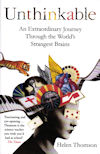The brain is amazing, and amazingly complex. One way to learn about how it works is to study it when it goes wrong, or behaves differently from normal. Here Thomson, following in the footsteps of Oliver Sacks, provides multiple different windows onto different brains. Each of the nine main chapters is based on a single person with a particular difference, with a personal conversation, discussion of other similar cases, and some suggestions of what is going on, or not going on, in these different brains.
We get a man with a perfect autobiographical memory, a woman who can’t find her way around (Developmental topographical disorientation), a colour-blind man who sees people with colourful auras (synaesthesia), a man whose personality changed after an electric shock and is now compelled to paint all day (sudden artistic output syndrome), a deaf woman who constantly hallucinates music (Musical ear syndrome, an aural version of Charles Bonnet syndrome), a schizophrenic man who thinks he is a tiger (clinical lycanthropy), a woman completely detached from her feelings (depersonalisation disorder), a man who thought he was dead (Cotard’s syndrome), and a man who can feel what other people feel (mirror-touch synaesthesia). The fact that these disorders have medical names shows that these people are not unique: there is something reproducible and systematic going on here.
The colour-blind synaesthete tale sparks a question. The chapter starts off recounting an experiment demonstrating that people can’t actually see “auras”, and goes on to explain the particular subject’s perception of colours in terms of his synaesthesia. Putting these together: maybe most of those people who claim to see auras aren’t lying, aren’t con artists; maybe they are just mistaken, misinterpreting their own synaesthetic perceptions?
Several of the other chapters make me want to build some sort of unified brain model (I will resist the temptation). This thought initially started on reading Dennett’s Intuition Pumps, which made me wonder if blindsight recognition and Capgras delusion are just two sides of the same coin: emotional and rational perceptions being out of synch. Many of the descriptions here are similar: the brain is a mass of different models – rational, emotional, perceptual, proprioceptual, predictive, generative, and more – and it needs to integrate all of these coherently for “normal” cognition and feeling. If one or more of these models fails to be properly integrated, there appears to be something out of kilter with the world. The brain desperately tries to make sense of these contradictions, and “explains” the situation the best it can, with bizarre consequences. Different models failing to integrate give different problems, helping us understand how they do usually integrate. (So much for simple rational-only models of artificial intelligence.)
So there is much food for thought here, told in an accessible style.
